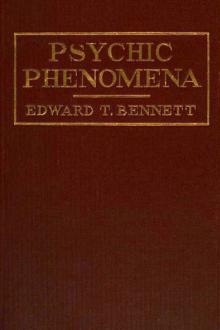The Beautiful by Vernon Lee (red queen free ebook .txt) 📖

- Author: Vernon Lee
- Performer: -
Book online «The Beautiful by Vernon Lee (red queen free ebook .txt) 📖». Author Vernon Lee
This question of the purifying power of the Beautiful has brought us back to our starting-point. It illustrates the distinction between contemplating an aspect and thinking about things, and this distinction's corollary that shape as such is yon-side of real and unreal, taking on the character of reality and unreality only inasmuch as it is thought of in connexion with a thing. As regards the possibility of being good or evil, it is evident from all the foregoing that shape as shape, and without the suggestion of things, can be evil only in the sense of being ugly, ugliness diminishing its own drawbacks by being, ipso facto, difficult to dwell upon, inasmuch as it goes against the grain of our perceptive and empathic activities. The contemplation of beautiful shape is, on the other hand, favoured by its pleasurableness, and such contemplation of beautiful shape lifts our perceptive and empathic activities, that is to say a large part of our intellectual and emotional life, on to a level which can only be spiritually, organically, and in so far, morally beneficial.
CHAPTER XXI
CONCLUSION (EVOLUTIONAL)
SOME of my Readers, not satisfied by the answer implicit in the last chapter and indeed in the whole of this little book, may ask a final question concerning our subject. Not: What is the use of Art? since, as we have seen, Art has many and various uses both to the individual and to the community, each of which uses is independent of the attainment of Beauty.
The remaining question concerns the usefulness of the very demand for Beauty, of that Aesthetic Imperative by which the other uses of art are more or less qualified or dominated. In what way, the Reader may ask, has sensitiveness to Beauty contributed to the survival of mankind, that it should not only have been preserved and established by evolutional selection, but invested with the tremendous power of the pleasure and pain alternative?
The late William James, as some readers may remember, placed musical pleasure between sentimental love and sea-sickness as phenomena unaccountable by any value for human survival, in fact masteries, if not paradoxes, of evolution.
The riddle, though not necessarily the mystery, does not consist in the survival of the aesthetic instinct of which the musical one is a mere sub-category, but in the origin and selectional establishment of its elementary constituents, say for instance space-perception and empathy, both of which exist equally outside that instinct which is a mere compound of them and other primary tendencies. For given space-perception and empathy and their capacity of being felt as satisfactory or unsatisfactory, the aesthetic imperative is not only intelligible but inevitable. Instead therefore of asking: Why is there a preference for what we call Beauty? we should have to ask: why has perception, feeling, logic, imagination, come to be just what it is? Indeed why are our sense-organs, our bodily structure and chemical composition, what they are; and why do they exist at all in contradistinction to the ways of being of other living or other inanimate things? So long as these elementary facts continue shrouded in darkness or taken for granted, the genesis and evolutional reason of the particular compound which we call aesthetic preference must remain only one degree less mysterious than the genesis and evolutional reason of its psychological components.
Meanwhile all we can venture to say is that as satisfaction derived from shapes we call beautiful, undoubtedly involves intense, complex, and reiterative mental activities, as it has an undeniable power for happiness and hence for spiritual refreshment, and as it moreover tends to inhibit most of the instincts whose superabundance can jeopardise individual and social existence, the capacity for such aesthetic satisfaction, once arisen, would be fostered in virtue of a mass of evolutional advantages which are as complex and difficult to analyse, but also as deep-seated and undeniable, as itself.
BIBLIOGRAPHY
I. Lipps. Raumaesthetik, Leipzig, 1897.
" Aesthetik, vol. I. part ii., Leipzig, 1906.
II. Karl Groos. Aesthetik, Giessen, 1892.
" Der Aesthetische Genuss, Giessen, 1902.
III. Wundt. Physiologische Psychologie (5th Edition, 1903), vol. III. pg. 107 to 209. But the whole volume is full of indirect suggestion on aesthetics.
IV. Münsterberg. The Principles of Art Education, New York, 1905. (Statement of Lipps' theory in physiological terms.)
V. Külpe. Der gegenwärtige Stand der experimentellen Aesthetik, 1907.
VI. Vernon Lee and Anstruther-Thomson. Beauty and Ugliness, 1912 (contains abundant quotations from most of the above works and other sources).
VII. Ribot. Le Rôle latent des Images Motrices. Revue Philosophique, March 1912.
VIII. Witasek. Psychologie der Raumwahrnehmung des Auges (1910). These two last named are only indirectly connected with visual aesthetics.
For art-evolutional questions consult:
IX. Haddon. Evolution in Art, 1895.
X. Yrjö Hirn. Origins of Art, Macmillan, 1900.
XI. Levinstein. Kinderzeichnungen, Leipzig, 1905.
XII. Loewy. Nature in early Greek Art (translation), Duckworth, 1907.
XIII. Delia Seta. Religione e Arte Figurata, Rome, 1912.
XIV. Spearing. The Childhood of Art, 1913.
XV. Jane Harrison. Ancient Art and Ritual, 1913.
INDEX
Aesthetic:
aridity, 136-7;
imperative, 99-100;
irradiation, 147-52;
purification, 149-52;
responsiveness, active nature of, 128-36;
habit and familiarity affecting, 134-6
Altamira cave frescoes, 95
Art:
differential characteristic of, 116-18;
non-aesthetic aims of, 99-100, 137-8; utility of, 153-5
Aspect:
aesthetics concerned with, 15, 21, 105;
shape the determining feature of, 26-8
Attention, a factor distinguishing perception from sensation, 32
Balfour, H., 95
Beautiful:
aesthetic irradiation proceeding from use of adjective, 147-8;
attitude implied by use of adjective, 2-7, 18-19;
empathy the chief factor of preference, 67-8;
implies desire for reiterated perception, 53-4
Botticelli, 83
Brahms' German Requiem, 150
Browning's Abt Vogler, 141
Coleridge's Ode to Dejection, 131
Colour, passive reception of, 23-4, 29
Contemplative satisfaction marking aesthetic attitude, 8-15
Correggio's Danae, 151
Cubic Existence:
perception of, 85;
pictorial suggestion of, importance attached to, discussed, 101-5
Discobolus, 115
Einfühlung, 59;
misinterpretations of, 66-7
Emotion, storage and transfer of, 139-46
Empathy, 61-69;
complexity of movements of lines, 78-83;
movements of lines, 70-77;
second element of shape-perception, 59-60
Extension existing in perception, 35-8
Fechner, 130
Hildebrand, 102, 118
Inner Mimicry, 74-5
James, W., 153
Keats' Grecian Urn, 77
Levinstein, 96
Lipps, 66
Locomotion of Things, distinction between, and empathic movement of lines, 111-16
Lotze, 66
Mantegna, 82
Memory:
a factor distinguishing perception from sensation, 32;
in perception, 40-1
Michel Angelo, 114, 122
Movement of Lines, distinction between, and locomotion of Things, 111-16; see also Empathy
Object of Perception, subject's activities merged in, 57, 58
Perception:
active process involved in, 29-34, 128-9;
distinguished from sensation, 32;
subject and object of, 55-60
Raphael's Heliodorus, 119
Relaxation an element of form-perception, 42
Rembrandt, 122
Rythm, 42-5
Semper, hypothesis regarding shape-preference, 94
Sensations:
distinguished from perceptions, 32;
perception of relation between, 29-30
Shape:
character of, 78-83;
contemplation of, its intermittent but recurrent character, 106-10;
determines contemplation of an aspect, 26-8;
elements of, 35-47;
Empathy an element of perception of, 59;
facility and difficulty of grasping, 48-54;
a perception, 29-34;
practical causes regarding evolution of, 90-4;
preference, its evolution, 94-7;
and Things, their co-operation, 117-27;
thinking away from, to Things, 131-2, 84-9
Sound, passive reception of, 23-4, 29
Subject of perception, extent of awareness of self, 57-9
Symmetry, 42-3
Tension, an element of form-perception, 42
Things and Shapes, their cooperation, 117-27;
thoughts about, entering into shape-contemplation, 84-9
Third Dimension, locomotor nature of knowledge of, 85-6, 101
Titchener, 59
Vinci, Leonardo da, 83, 145-6
Vischer, 66
Watts, G. F., 46
Whole and Parts, perception of relation of, 48-54
Wilde's Salome, 150
Wundt, 42, 66
End of the Project Gutenberg EBook of The Beautiful, by Vernon Lee
*** END OF THIS PROJECT GUTENBERG EBOOK THE BEAUTIFUL ***
***** This file should be named 26942-h.htm or 26942-h.zip *****
This and all associated files of various formats will be found in:
http://www.gutenberg.org/2/6/9/4/26942/
Produced by Ruth Hart
Updated editions will replace the previous one--the old editions
will be renamed.
Creating the works from public domain print editions means that no
one owns a United States copyright in these works, so the Foundation
(and you!) can copy and distribute it in the United States without
permission and without paying copyright royalties. Special rules,
set forth in the General Terms of Use part of this license, apply to
copying and distributing Project Gutenberg-tm electronic works to
protect the PROJECT GUTENBERG-tm concept and trademark. Project
Gutenberg is a registered trademark, and may not be used if you
charge for the eBooks, unless you receive specific permission. If you
do not charge anything for copies of this eBook, complying with the
rules is very easy. You may use this eBook for nearly any purpose
such as creation of derivative works, reports, performances and
research. They may be modified and printed and given away--you may do
practically ANYTHING with public domain eBooks. Redistribution is
subject to the trademark license, especially commercial
redistribution.
*** START: FULL LICENSE ***
THE FULL PROJECT GUTENBERG LICENSE
PLEASE READ THIS BEFORE YOU DISTRIBUTE OR USE THIS WORK
To protect the Project Gutenberg-tm mission of promoting the free
distribution of electronic works, by using or distributing this work
(or any other work associated in any way with the phrase "Project
Gutenberg"), you agree to comply with all the terms of the Full Project
Gutenberg-tm License (available with this file or online at
http://gutenberg.org/license).
Section 1. General Terms of Use and Redistributing Project Gutenberg-tm
electronic works
1.A. By reading or using any part of this Project Gutenberg-tm
electronic work, you indicate that you have read, understand, agree to
and accept all the terms of this license and intellectual property
(trademark/copyright) agreement. If you do not agree to abide by all
the terms of this agreement, you must cease using and return or destroy
all copies of Project Gutenberg-tm electronic works in your possession.
If you paid a fee for obtaining a copy of or access to a Project
Gutenberg-tm electronic work and you do not agree to be bound by the
terms of this agreement, you may obtain a refund from the person or
entity to whom you paid the fee as set forth in paragraph 1.E.8.
1.B. "Project Gutenberg" is a registered trademark. It may only be
used on or associated in any way with an electronic work by people who
agree to be bound by the terms of this agreement. There are a few
things that you can do with most Project Gutenberg-tm electronic works
even without complying with the full terms of this agreement. See
paragraph 1.C below. There are a lot of things you can do with Project
Gutenberg-tm electronic works if you follow the terms of this agreement
and help
 A very interesting statement of one of our contemporaries is that any person, to one degree or another, is both a psychologist and a philosopher - they say, life forces him to. On the one hand, the main driving force of every person is the craving for knowledge, the desire to reach certain social heights, the desire to be wise in any everyday situations - and this is the philosophy of life.
A very interesting statement of one of our contemporaries is that any person, to one degree or another, is both a psychologist and a philosopher - they say, life forces him to. On the one hand, the main driving force of every person is the craving for knowledge, the desire to reach certain social heights, the desire to be wise in any everyday situations - and this is the philosophy of life. 




Comments (0)